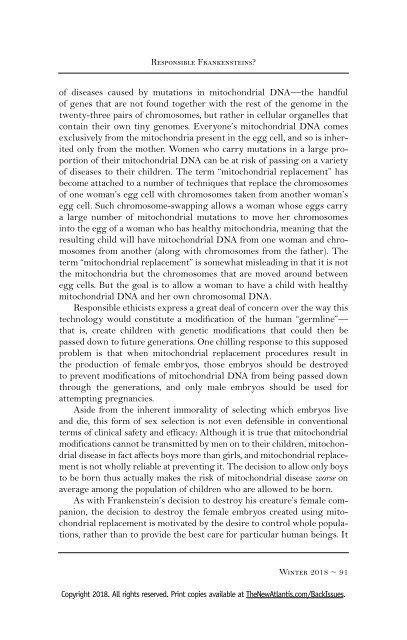The New Atlantis - Winter 2018 (Issue 54) uncompressed with cover
Create successful ePaper yourself
Turn your PDF publications into a flip-book with our unique Google optimized e-Paper software.
Responsible Frankensteins?<br />
of diseases caused by mutations in mitochondrial DNA — the handful<br />
of genes that are not found together <strong>with</strong> the rest of the genome in the<br />
twenty-three pairs of chromosomes, but rather in cellular organelles that<br />
contain their own tiny genomes. Everyone’s mitochondrial DNA comes<br />
exclusively from the mitochondria present in the egg cell, and so is inherited<br />
only from the mother. Women who carry mutations in a large proportion<br />
of their mitochondrial DNA can be at risk of passing on a variety<br />
of diseases to their children. <strong>The</strong> term “mitochondrial replacement” has<br />
become attached to a number of techniques that replace the chromosomes<br />
of one woman’s egg cell <strong>with</strong> chromosomes taken from another woman’s<br />
egg cell. Such chromosome-swapping allows a woman whose eggs carry<br />
a large number of mitochondrial mutations to move her chromosomes<br />
into the egg of a woman who has healthy mitochondria, meaning that the<br />
resulting child will have mitochondrial DNA from one woman and chromosomes<br />
from another (along <strong>with</strong> chromosomes from the father). <strong>The</strong><br />
term “mitochondrial replacement” is somewhat misleading in that it is not<br />
the mitochondria but the chromosomes that are moved around between<br />
egg cells. But the goal is to allow a woman to have a child <strong>with</strong> healthy<br />
mitochondrial DNA and her own chromosomal DNA.<br />
Responsible ethicists express a great deal of concern over the way this<br />
technology would constitute a modification of the human “ germline” —<br />
that is, create children <strong>with</strong> genetic modifications that could then be<br />
passed down to future generations. One chilling response to this supposed<br />
problem is that when mitochondrial replacement procedures result in<br />
the production of female embryos, those embryos should be destroyed<br />
to prevent modifications of mitochondrial DNA from being passed down<br />
through the generations, and only male embryos should be used for<br />
attempting pregnancies.<br />
Aside from the inherent immorality of selecting which embryos live<br />
and die, this form of sex selection is not even defensible in conventional<br />
terms of clinical safety and efficacy: Although it is true that mitochondrial<br />
modifications cannot be transmitted by men on to their children, mitochondrial<br />
disease in fact affects boys more than girls, and mitochondrial replacement<br />
is not wholly reliable at preventing it. <strong>The</strong> decision to allow only boys<br />
to be born thus actually makes the risk of mitochondrial disease worse on<br />
average among the population of children who are allowed to be born.<br />
As <strong>with</strong> Frankenstein’s decision to destroy his creature’s female companion,<br />
the decision to destroy the female embryos created using mitochondrial<br />
replacement is motivated by the desire to control whole populations,<br />
rather than to provide the best care for particular human beings. It<br />
<strong>Winter</strong> <strong>2018</strong> ~ 91<br />
Copyright <strong>2018</strong>. All rights reserved. Print copies available at <strong>The</strong><strong>New</strong><strong>Atlantis</strong>.com/Back<strong>Issue</strong>s.


